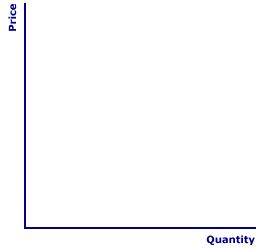
|
|
AFL-CIO: The umbrella organization for many labor unions in the United States, with AFL standing for American Federation of Labor, and CIO the abbreviation of Congress of Industrial Organizations. The AFL-CIO began as just the AFL in 1886 as a collection of craft unions representing skilled workers. It expanded to include semiskilled and unskilled workers represented by industrial unions. Differing interests among the two groups lead to a division of the original AFL in 1938 into two separate groups -- the AFL containing craft unions and CIO containing industrial unions. This rift was closed in 1955, when the AFL and CIO merged to form the AFL-CIO.
Visit the GLOSS*arama
|
|


|

|
                           UNIT ELASTIC: An elasticity alternative in which changes in one variable (usually price) cause equal proportional changes in another variable (usually quantity). In other words, any change in price, whether big or small, triggers exactly the same percentage change in quantity. Quantity changes match price changes. This characterization of elasticity is most important for the price elasticity of demand and the price elasticity of supply. Unit elastic is one of five elasticity alternatives. The other four are perfectly elastic, perfectly inelastic, relatively elastic, and relatively inelastic. | Alternative | Coefficient (E) | | Perfectly Elastic | E = ∞ | | Relatively Elastic | 1 < E < ∞ | | Unit Elastic | E = 1 | | Relatively Inelastic | 0 < E < 1 | | Perfectly Inelastic | E = 0 |
Unit elastic means that any change in price causes an equal proportion change in quantity. Quantity changes are matched by price changes. More specifically, the percentage change in quantity is equal to the percentage change in price. Unit elastic demand occurs when buyers can choose from among a modest number of substitutes in the consumption of a good. In an analogous way, unit elastic supply occurs when sellers can choose among a modest number of substitutes in the production.The chart to the right displays the five alternatives based on the coefficient of elasticity (E). In technical shorthand (which can be used by anyone with math symbols tattooed on their hands), the coefficient of elasticity (E) is given as: E = 1 This technical shorthand works for both the price elasticity of demand and the price elasticity of supply, because the negative value of the price elasticity of demand is ignored. If the negative sign is not ignored, the price elasticity of demand is given by E = -1 Two Curves| Unit Elastic Curves |  |
Unit elastic demand and supply are best understood and more easily seen with pictures. The blank graph presented here is ready and willing to display a unit elastic demand curve and a unit elastic supply curve. All this is needed is click the corresponding buttons labeled [Demand] and [Supply].Notice that the unit elastic demand curve is, in fact, a curve (rather than a straight line), while the unit elastic supply curve is a straight line that originates from the origin. Both curves are configured such that a given percentage change in price is matched by an equal percentage change in quantity. The key for demand is that the slope of the curve is steep for high prices and small quantities and flat for low prices and large quantities. The key for supply is that the line goes through the origin. If the price is zero, so too is the quantity. Examples Anyone?While it would be useful to discuss a few examples of unit elastic demand and supply, such is not really possible. This is not due to any moral, religious, or philosophical objection to doing so. It is because that, unlike other elasticity alternatives, there is nothing particularly notable about goods that are unit elastic. Rather than a distinctive category, unit elastic is primarily a dividing line, a boundary, between elastic and inelastic. If the coefficient of elasticity is greater than one, then a good is elastic. If the coefficient of elasticity is less than one, then a good is inelastic. If the coefficient just happens to be exactly equal to one, then it is unit elastic. There is nothing intrinsic about a good in terms of either production or consumption that give rise to unit elastic.

Recommended Citation:UNIT ELASTIC, AmosWEB Encyclonomic WEB*pedia, http://www.AmosWEB.com, AmosWEB LLC, 2000-2024. [Accessed: April 29, 2024].
Check Out These Related Terms... | | | | | | | | | | | | | |
Or For A Little Background... | | | | | | | | | | |
And For Further Study... | | | | | | | |
Search Again?
Back to the WEB*pedia
|



|

|
PINK FADFLY
[What's This?]
Today, you are likely to spend a great deal of time looking for a downtown retail store wanting to buy either a coffee cup commemorating the 2000 Olympics or a birthday gift for your grandmother. Be on the lookout for a thesaurus filled with typos.
Your Complete Scope
This isn't me! What am I?
|

|
|
The first "Black Friday" on record, a friday marked by a major financial catastrophe, occurred on September 24, 1869 -- A FRIDAY -- when an attempted cornering of the gold market induced a financial crises and economy-wide depression.
|

|
|
"Something in human nature causes us to start slacking off at our moment of greatest accomplishment. As you become successful, you will need a great deal of self-discipline not to lose your sense of balance, humility and commitment." -- H. Ross Perot
|

|
SMSA
Standard Metropolitan Statistical Area
|

|
|
Tell us what you think about AmosWEB. Like what you see? Have suggestions for improvements? Let us know. Click the User Feedback link.
User Feedback
|


|


